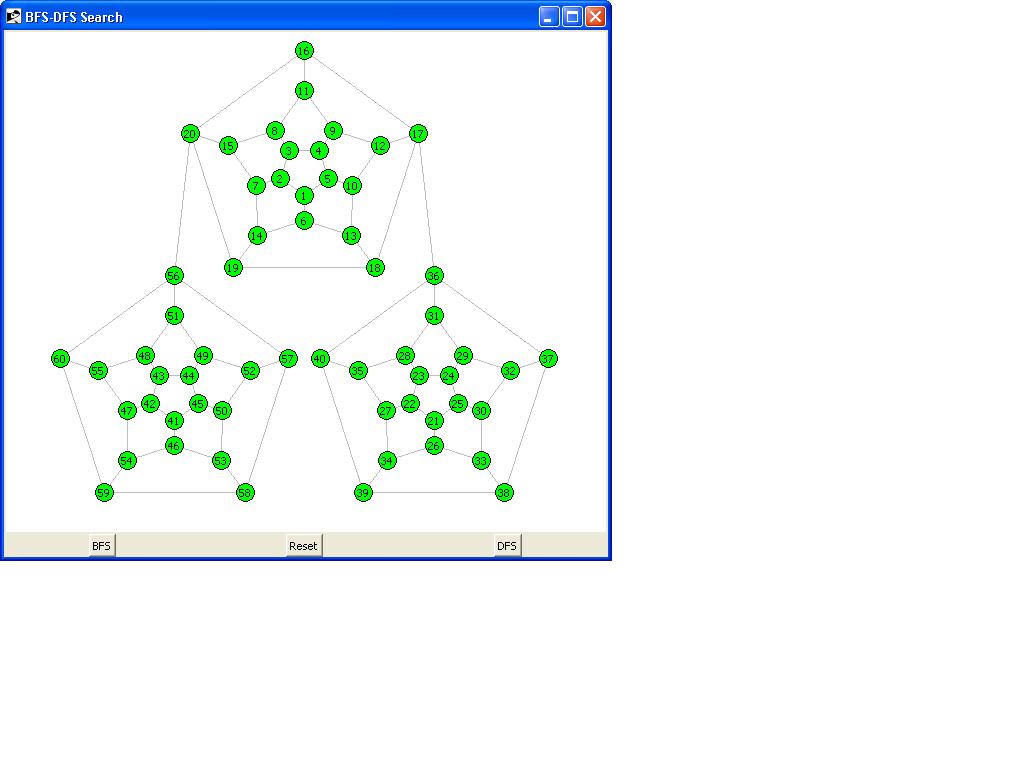Graphs: BFS an DFS animated demo
Description
FF - 2009-01-30 - This program is an animated demonstration of BFS and DFS searches.
Jeff Smith 2019-07-18 : Below is an online demo using CloudTk
Changes
PYK 2012-12-03: removed update
JM 2010-11-27: fixed "::seq": no such variable" error in addVertex
Code
# Some GUI stuff (canvas and buttons)
package require Tk
canvas .c -width 600 -height 500 -background white
grid .c -row 0 -column 0 -columnspan 3
button .bfs -text "BFS" -command {enable 0; bfs 0; enable 1}
button .rst -text "Reset" -command {reset}
button .dfs -text "DFS" -command {enable 0; dfs 0; enable 1}
grid .bfs .rst .dfs -row 1
# I used an array for storing vertices and another array for storing edges.
# I keep x,y positions inside the vertices array, just a sa convenience (I'm thinking of doing another demo on weighted graphs, and the position could be used to automatically calculate the weight across nodes)
# the edges are stored in the array, as a unique key $a:$b where $a and $b are the vertex identifiers
# the addEdge proc can make both directed and undirected edges, and accepts a weight argument (if 'auto' it will compute the weight from $x,$y position of the vertex
proc addVertex {x y} {
if {![info exists ::seq]} {set ::seq 0}
set ::vertex($::seq) [list $x $y]
set r 9
.c create oval \
[expr {$x-$r}] [expr {$y-$r}] \
[expr {$x+$r}] [expr {$y+$r}] \
-fill green -outline black \
-tags [list vertex vertex:$::seq]
.c create text $x $y -text [expr {1+$::seq}] \
-tags [list vertex_id vertex_id:$::seq]
return [expr {[incr ::seq]-1}]
}
proc addEdge {a b {bidi 1} {weight auto}} {
if {$a == $b} {return}
set dx [expr {[lindex $::vertex($b) 0]-[lindex $::vertex($a) 0]}]
set dy [expr {[lindex $::vertex($b) 1]-[lindex $::vertex($a) 1]}]
set ::edge($a:$b) $weight
if $bidi {set ::edge($b:$a) $weight}
.c create line \
[lindex $::vertex($a) 0] [lindex $::vertex($a) 1] \
[lindex $::vertex($b) 0] [lindex $::vertex($b) 1] \
-fill gray
.c raise vertex
.c raise vertex_id
if {$weight == "auto"} {
set weight [expr {sqrt($dx*$dx+$dy*$dy)}]
} elseif {$weight == 0} {
return
}
.c create text \
[expr {[lindex $::vertex($a) 0]+$dx/2}] \
[expr {[lindex $::vertex($a) 1]+$dy/2}] \
-text [expr {int($weight)}]
}
# getting the adjacent vertices (very easy). note that I preprocess the results by splitting on the ':' character used in the array key
proc adj v {
set r {}
foreach v [array names ::edge $v:*] {lappend r [lindex [split $v :] 1]}
return $r
}
# the BFS is non-recursive, and uses a queue (implemented with plain lists) to store the vertices to visit:
proc bfs {s {v {}}} {
variable busy
set bfsseq 0
if {$s != {}} {
set pop [lindex $s 0]
set s [lrange $s 1 end]
foreach adj [adj $pop] {
if {[lsearch -exact $v $adj] < 0} {
lappend s $adj
}
}
if {[lsearch -exact $v $pop] < 0} {
lappend v $pop
visit $pop [incr bfsseq]
set wait 400
} else {
set wait 0
}
set busy [after $wait [list after idle [list [namespace current]::bfs $s $v]]]
}
}
# also the DFS is non-recursive, but uses a stack (also implemented with plain lists) to store vertices to visit
proc dfs {s {v {}}} {
variable busy
set dfsseq 0
if {$s != {}} {
set pop [lindex $s 0]
set s [lrange $s 1 end]
foreach adj [adj $pop] {
if {[lsearch -exact $v $adj] < 0} {
set s [linsert $s 0 $adj]
}
}
if {[lsearch -exact $v $pop] < 0} {
lappend v $pop
visit $pop [incr dfsseq]
set wait 400
} else {
set wait 0
}
set busy [after $wait [list after idle [list [namespace current]::dfs $s $v]]]
}
}
# the visit consists of just visually marking the vertex, and showing the time of visit (sequential number)
proc visit {s seq} {
.c itemconfigure vertex:$s -fill black
.c itemconfigure vertex_id:$s -fill white
.c create text \
[expr {10+[lindex $::vertex($s) 0]}] [lindex $::vertex($s) 1] \
-text $seq -fill blue -anchor w -tags visit
}
# other GUI stuff follows:
proc reset {} {
variable busy
after cancel $busy
.c delete visit
.c itemconfigure vertex -fill green
.c itemconfigure vertex_id -fill black
}
proc enable {b} {
if $b {set b active} {set b disabled}
foreach w {.bfs .dfs .rst} {$w configure -state $b}
}
proc initGraph {x y} {
set Q 150 ; set off 0
for {set h 0} {$h < 3} {incr h} {
set t [expr {$h*atan(1)*8.0/3}]
set xx [expr {$x+cos($t+atan(1)*6)*$Q}]
set yy [expr {$y+sin($t+atan(1)*6)*$Q}]
set R {25 50 80 120} ; set O {0.5 0.5 1.5 1.5}
for {set n 0} {$n < [llength $R]} {incr n} {
set r [lindex $R $n] ; set o [lindex $O $n]
for {set i 0} {$i < 5} {incr i} {
set t [expr {$i*atan(1)*8.0/5}]
set xxx [expr {$xx+cos($t+atan(1)*$o*4)*$r}]
set yyy [expr {$yy+sin($t+atan(1)*$o*4)*$r}]
addVertex $xxx $yyy
}
}
for {set j 0} {$j < 5} {incr j} {
foreach {z1 z2 w} {0 0 1 0 5 0 10 15 0 15 15 1 5 10 3 5 10 2} {
addEdge [expr {$z1+$off+$j}] [expr {$z2+$off+($j+$w)%5}] 1 0
}
}
incr off 20
}
addEdge 19 55 1 0 ; addEdge 16 35 1 0
}
initGraph 300 290